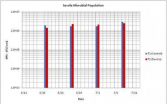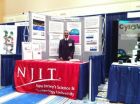Trio of drugs may combat 'triple negative' breast cancer
2010-12-11
(Press-News.org) A gene target for drug resistance, a triple-drug cocktail for triple negative breast cancer, and patients' risk for carpal tunnel syndrome are among study highlights scheduled to be presented by Johns Hopkins Kimmel Cancer Center scientists during the 33rd Annual CTRC-AACR San Antonio Breast Cancer Symposium, held Dec. 8-12. The information is embargoed for the time of presentation at the symposium.
TRIO OF DRUGS MAY COMBAT "TRIPLE NEGATIVE" BREAST CANCER
(Presentation # PD01-05)
Working with cell cultures and mouse models, researchers at the Johns Hopkins Kimmel Cancer Center have tested a cocktail of three drugs that holds promise for treating so-called triple negative breast cancers.
Women with such cancers lack all three hormone receptors – estrogen, progesterone and human epidermal growth factor 2 (HER2). Currently, treatments for triple negative breast cancers are limited to surgery, chemotherapy and radiation, which provide some improvements but overall poor prognoses.
In the new study, Johns Hopkins scientists began with a drug called Entinostat, which blocks an enzyme that unfolds DNA, providing regulatory molecules access to genes within and also reactivates a gene called retinoic acid receptor-beta (RARβ). Then, they added a drug called All Trans Retinoic Acid (ATRA), related to Vitamin A, which binds a protein made by the reactivated RARβ gene. Together, the ATRA drug and RARβ gene act as a brake on cancer cell growth. The scientists completed the drug cocktail with conventional chemotherapy using either low doses of doxorubicin or paclitaxel.
According to the scientists, each of the three drugs used alone may have some effect on killing tumors cells, but combining them tips the scale in favor of killing more cells.
Tests on laboratory-cultured cells showed that the triple combo therapy halted the growth of multiple triple negative breast cancer cell lines more effectively than any one of the treatments alone. The combined therapy also rejuvenated the expression of RARβ, and strongly inhibited tumor growth in three-quarters of mice engrafted with breast tumor cells.
The researchers are discussing potential clinical trials of the combo therapy, which they hope to start in the next year, says Nguyen K. Nguyen, a graduate student in the Cellular and Molecular Medicine Program at Johns Hopkins.
INFORMATION:
On the Web:
www.hopkinskimmelcancercenter.org
San Antonio Breast Cancer Symposium: http://www.sabcs.org/
END
ELSE PRESS RELEASES FROM THIS DATE:
2010-12-11
A gene target for drug resistance, a triple-drug cocktail for triple negative breast cancer, and patients' risk for carpal tunnel syndrome are among study highlights scheduled to be presented by Johns Hopkins Kimmel Cancer Center scientists during the 33rd Annual CTRC-AACR San Antonio Breast Cancer Symposium, held Dec. 8-12. The information is embargoed for the time of presentation at the symposium.
SIMPLE FINGERTIP TEST MAY IDENTIFY BREAST CANCER PATIENTS AT RISK FOR CARPAL TUNNEL SYNDROME
(Presentation # P2-14-09)
As many as half of postmenopausal women taking aromatase ...
2010-12-11
PITTSBURGH— Nonchemical treatment systems are touted as environmentally conscious stand-ins for such chemicals as chlorine when it comes to cleaning the water-based air-conditioning systems found in many large buildings. But a recent study by University of Pittsburgh researchers suggests that this diverse class of water-treatment devices may be ineffective and can allow dangerous bacteria to flourish in the cooling systems of hospitals, commercial offices, and other water-cooled buildings almost as much as they do in untreated water.
The two-year study by a team in Pitt's ...
2010-12-11
"Directed Self-Assembly of Vertical Nanotubes for Biosensors, Logic, and Nano-Biofuel Cells," will be the focus of NJIT's exhibit today
at the National Nanotechnology Innovation Summit 10 http://www.nsti.org/events/NNI/, at the Gaylord Center in Washington, DC. The event celebrates the 10th anniversary of the national nanotechnology initiative.
NJIT was the only university in New Jersey selected for this exposition featuring practical applications of nanoscience resulting from the last decade of federal funding under the National Nanotechnology Initiative (NNI). ...
2010-12-11
DALLAS – Dec. 10, 2010 – It's a medical Catch-22: carotid artery surgery can itself cause stroke, but so can asymptomatic carotid disease if left untreated.
UT Southwestern Medical Center researchers have now developed a clinical risk prediction rule using factors such as sex, race and health history to assess the danger the surgery poses, while a modified version will help patients make a more fully informed choice about whether to have the procedure.
"It may take a thief to catch a thief, but physicians don't want to cause stroke while trying to prevent stroke, so ...
2010-12-11
GALVESTON, Texas — "You'll be back on your feet in no time" is a phrase familiar to anyone who's ever had to spend time in a hospital. Now, a new study has shown that hospitalized elderly patients who literally "get back on their feet" by taking even short walks around a hospital unit tend to leave the hospital sooner than their more sedentary peers.
Conducted at the University of Texas Medical Branch at Galveston and described in a paper appearing in the current issue of Archives of Internal Medicine, the study draws on data collected from 162 hospitalized patients over ...
2010-12-11
It is estimated that 38 million people worldwide are currently infected with HIV and that 4.1 million more are added each year. For scientists to design treatment therapies that are effective over the long-term it is essential to learn more about how the virus mutates and develops resistance to medications.
New, groundbreaking research by University of Victoria biomedical engineer Stephanie Willerth has significantly advanced the understanding of HIV and how to treat it.
"The virus mutates at a very high rate which is very problematic for HIV patients because the virus ...
2010-12-11
(Washington, DC) – A recent study of the use of metaphors in spoken language and various sign languages shows that certain types of metaphors are difficult to convey in sign language. The study, "Iconicity and metaphor: Constraints on metaphorical extension of iconic forms," to be published in the December 2010 issue of the scholarly journal Language, is authored by Irit Meir of the University of Haifa. A preprint version is available on line at:
http://lsadc.org/info/documents/2010/press-releases/meir.pdf.
Dr. Meir's research sheds new light on the interrelations between ...
2010-12-11
The December issue of The Quarterly Review of Biology is now available. The issue features articles on the nature of individual organisms, evolution observed in the lab, play behavior across animal species, and a criticism of intelligent design creationism. Abstracts are available at http://www.journals.uchicago.edu/toc/qrb/current.
What is an Individual?
For organisms like fish, mice, and people, it's not hard to distinguish between individuals. However, for colonial creatures like corals and anemones, and for organisms like slime molds and bacteria, the line separating ...
2010-12-11
SAN FRANCISCO – Scientists from the Department of Energy's Pacific Northwest National Laboratory will present their research at the 2010 American Geophysical Union Fall Meeting, which runs Monday, Dec. 13 through Friday, Dec. 17 at the Moscone Convention Center in San Francisco.
SPLAT unearths complex view of airborne particles
Measuring individual particles instead of the average reveals a complex landscape
Climate researchers trying to characterize aerosol particles – tiny bits of organic molecules, sulfate, dust, soot and more – are limited to measuring averages, ...
2010-12-11
Alfred Lee and Don Campbell, authors of the internationally acclaimed book, Perfect Breathing: Transform Your Life One Breath at a Time (Sterling Publishing/New York City), today announced that the makers of BreathSlim , a revolutionary new breathing device that trains users to breathe correctly to fully utilize the power of oxygen, will begin excerpting relevant sections of Perfect Breathing to help users better understand the tremendous impact mindful breathing has on health, well-being and performance.
"We are excited about the potential of teaming up to share these ...
LAST 30 PRESS RELEASES:
[Press-News.org] Trio of drugs may combat 'triple negative' breast cancer

